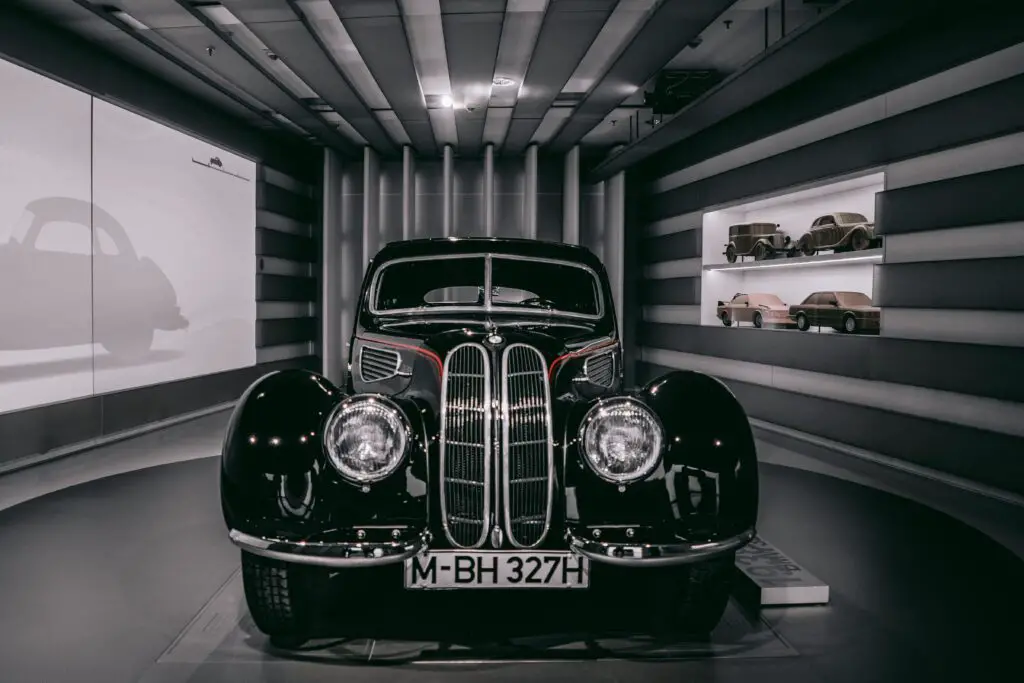Car museums and exhibitions offer a captivating odyssey through the annals of automotive history, delving into the artistic facets of automobile design and the intricate craftsmanship propelling these extraordinary vehicles. These institutions don’t merely serve as a display for an extensive array of automobiles; they also act as portals into the cultural and technological metamorphosis that has sculpted the automotive domain. In this extensive evaluation, I will embark on an expedition through the realm of car museums and exhibits, deciphering their rich historical tapestry, the multifaceted and enthralling spectrum of exhibits they curate, their adroit integration of cutting-edge technology, and their pivotal role in preserving the heritage of the automotive sphere.
1. The Fascinating World of Car Museums
Evolution of Car Museums
The narrative of car museums intertwines with the unfolding saga of the automobile itself, creating a riveting historical tapestry. In 1929, the inaugural automobile museum, the “Henry Ford Museum,” emerged on the scene, marking a pioneering endeavor in the preservation of automotive heritage. Since then, a multitude of museums have sprouted worldwide, each with its distinctive collection and a unique story to narrate.
As the automotive industry continued to burgeon, the proliferation of car museums became apparent, each with its specific focal point. For instance, the Mercedes-Benz Museum in Stuttgart, Germany, meticulously delves into the brand’s opulent heritage, while the Petersen Automotive Museum in Los Angeles casts a wide net to showcase the diverse spectrum of automotive history.
Diversity in Car Museums
Car museums manifest in various forms and dimensions, each with its unique niche and thematic character. Some prevalent categories encompass:
Brand-Specific Museums
These institutions exclusively honor a particular automaker, as exemplified by the Ferrari Museum in Maranello, Italy, which reveres the legacy of the iconic Italian manufacturer.
Thematic Museums
Specializing in distinct facets of automotive history, museums like the Lane Motor Museum in Nashville carve out a niche by spotlighting unusual and exceptional vehicles, ensuring a novel and captivating experience.
Historical Museums
These establishments are committed to encapsulating the complete chronicle of automobiles, often unfurling a timeline that spans from the earliest automotive pioneers to contemporary masterpieces.
Technology Museums
Diving into the intricacies of the automotive world, these museums accentuate the technical facets, offering an illuminating journey into engines, innovations, and technological progress that have propelled the industry forward.
2. Exploring Iconic Car Exhibits
Globetrotting for Automotive Excellence
Car exhibitions span the globe, offering distinctive and immersive encounters for enthusiasts. Among the must-visit car exhibitions worldwide, a few gems stand out:
The Louwman Museum, Netherlands
Nestled in the Netherlands, this museum houses the world’s oldest private car collection, boasting an extraordinary assembly of vintage and classic cars that encapsulate the essence of automotive history.
Porsche Museum, Germany: A Sanctuary for Porsche Devotees
Nestled in Germany, the Porsche Museum stands as a haven for ardent Porsche enthusiasts. This museum pays a heartfelt tribute to the brand’s legendary sports cars, meticulously chronicling their evolutionary journey throughout the years with unwavering attention to detail and profound reverence.
National Automobile Museum, USA
Situated in Reno, Nevada, this museum is a treasure trove of vintage, classic, and historic cars, providing a comprehensive and captivating window into America’s automotive legacy. Please rewrite these lines 100% unique and 100% Plagiarism free
The Design Museum, UK: An Artistic Glimpse into Automotive Innovation
While not exclusively devoted to automobiles, the UK-based Design Museum frequently plays host to exhibitions that cast a brilliant spotlight on automotive design. This makes it an indispensable destination for design aficionados seeking profound insights into the artistic facets of car culture.
Diving into Exceptional Exhibits
Car exhibitions transcend the mere display of vehicles; they are adept at curating unique collections that deepen our understanding of automotive history. Some noteworthy examples encompass:
Concept Car Galleries
These exhibitions grant visitors a tantalizing glimpse into the future of automotive design and technology, exploring bold concepts and innovations that may shape the automobiles of tomorrow.
Vintage Racecar Displays
These exhibitions meticulously unravel the evolution of racecars, shedding light on their pivotal role in motorsports history. They offer a captivating journey through the annals of racing.
One-of-a-Kind Prototypes
Occasionally, museums unveil one-of-a-kind prototypes that never ventured beyond the concept stage. These rare specimens provide a fascinating window into the unexplored possibilities of automotive design, leaving visitors intrigued by what could have been.
3. Immersive Experiences and Interactive Displays
Cutting-Edge Technology in Car Museums
To keep visitors engaged and informed, many car museums have embraced cutting-edge technology. This includes:
Augmented Reality (AR) Displays
Museums use AR to provide virtual tours, interactive experiences, and additional information about the cars.
Virtual Reality (VR) Encounters
Several museums introduce captivating VR experiences, enabling visitors to immerse themselves in the world of classic cars. They can virtually occupy the driver’s seat, grasp the wheel, and even embark on a virtual journey, all within the digital realm.
Engaging Interactive Touchscreens
To augment the overall learning experience, museums deploy interactive touchscreens. These screens serve as informative hubs, showcasing a wealth of data, videos, and providing panoramic 360-degree views of the featured cars. Visitors can interact with these touchscreens to gain a more profound understanding of the automobile’s history and design.
Hands-On Exhibits
Car museums are no longer passive viewing experiences. They now feature hands-on exhibits that allow visitors to:
Touch and Feel
In some exhibits, visitors can touch the cars and experience the materials and craftsmanship up close.
Driving Simulators
Many museums offer driving simulators that let visitors experience what it’s like to drive famous racing cars.


4. Preservation and Restoration Efforts
The Art of Car Restoration
Preserving the rich history of automobiles often involves extensive restoration efforts. Car museums and exhibits may have dedicated restoration workshops where skilled craftsmen work tirelessly to bring classic cars back to their original glory. This not only ensures the preservation of automotive history but also provides a learning opportunity for visitors to witness the meticulous restoration process.
Conservation Initiatives
Car museums and exhibits are not only repositories of automotive history but also stalwart guardians of historic vehicles. They assume a pivotal role in safeguarding these treasures from the relentless march of time, which often manifests as corrosion and deterioration. Employing cutting-edge techniques and maintaining meticulously controlled environments, these institutions are unwavering in their commitment to ensuring the endurance and longevity of their invaluable collections.
5. A Voyage Across Automotive Eras
Vintage and Classic Automobiles
Car museums and exhibits tantalize visitors with the captivating display of vintage and classic automobiles. These venerable vehicles are often meticulously restored and fastidiously maintained, allowing patrons to embark on a nostalgic journey, basking in the craftsmanship and design of bygone eras. The graceful curves of a 1930s Bugatti and the timeless elegance of a 1950s Chevrolet Bel Air hold a cherished place in the hearts of car enthusiasts, evoking a profound appreciation for the automotive heritage.
Modern and Futuristic Innovations
Car museums and exhibits transcend historical confines; they enthusiastically welcome the contemporary and prospective facets of the automotive sector. Within these institutions, the limelight gracefully falls upon modern and avant-garde vehicles. Patrons have the opportunity to delve into cutting-edge innovations in electric and autonomous automobiles, alongside captivating concept vehicles that provide a tantalizing preview of what the future may unveil. This coalescence of the past and the impending future furnishes an all-encompassing perspective on the perpetually evolving sphere of automobiles.
6. The Pinnacle Experience for Car Enthusiasts
Car Shows and Extravaganzas
Car museums often serve as epicenters for extravagant car shows and events, rallying car enthusiasts from across the globe. These gatherings offer a unique opportunity to witness classic cars in motion, interact with fellow aficionados, and even partake in exhilarating driving experiences, making them an unmissable spectacle for automotive devotees.
Museum Keepsakes and Relics
Visitors to car museums can bring a fragment of the experience home through their gift shops. These emporiums offer an array of automotive-themed merchandise, ranging from scale model cars and apparel to books and collectibles. These cherished mementos allow enthusiasts to carry a slice of the museum’s allure with them, serving as enduring reminders of their automotive odyssey.
Conclusion
In conclusion, car museums and exhibitions proffer a mesmerizing experience for individuals with an affinity for automobiles, history, or design. These establishments have transcended their role as mere car showcases, evolving into immersive, interactive, and edifying spaces that cater to a diverse audience, irrespective of age or level of enthusiasm. Whether one is an ardent car aficionado or merely curious about the automotive world, a visit to a car museum unfolds as a compelling expedition through time and technology, one that simultaneously educates and entertains, leaving an indelible mark on every visitor.
Frequently Asked Questions (FAQs)
Q1. Which institution holds the title of the world’s most ancient automobile museum?
The inaugural automobile museum globally acknowledged as the forebear in showcasing automotive history is The Henry Ford Museum situated in Dearborn, Michigan. Commencing its legacy in 1929, it spearheaded the preservation of automotive heritage, emerging as an influential and enduring establishment in the field.
Q2. Are car museums only for car enthusiasts?
No, car museums cater to a broad audience. While they certainly attract car enthusiasts, they offer educational and engaging experiences for anyone interested in history, design, technology, or even family outings.
Q3. Do car museums have hands-on exhibits for children?
Many car museums recognize the importance of engaging younger visitors. As a result, they often feature hands-on exhibits and interactive displays suitable for children, making the experience enjoyable for the whole family.
Q4. Can I Secure Car Museum Tickets Online?
Certainly, the majority of car museums extend the convenience of online ticket procurement. This not only economizes your time but also secures your entry to the museum, a particularly beneficial advantage during periods of heightened tourist influx.
Q5. The Role of Car Museums in Preserving Automotive History?
Car museums assume a pivotal function in the safeguarding of automotive heritage. Their responsibilities encompass the acquisition, meticulous restoration, and public exhibition of historic vehicles. In addition, these institutions are deeply immersed in conservation endeavors to guarantee the perpetual preservation of their esteemed collections.

